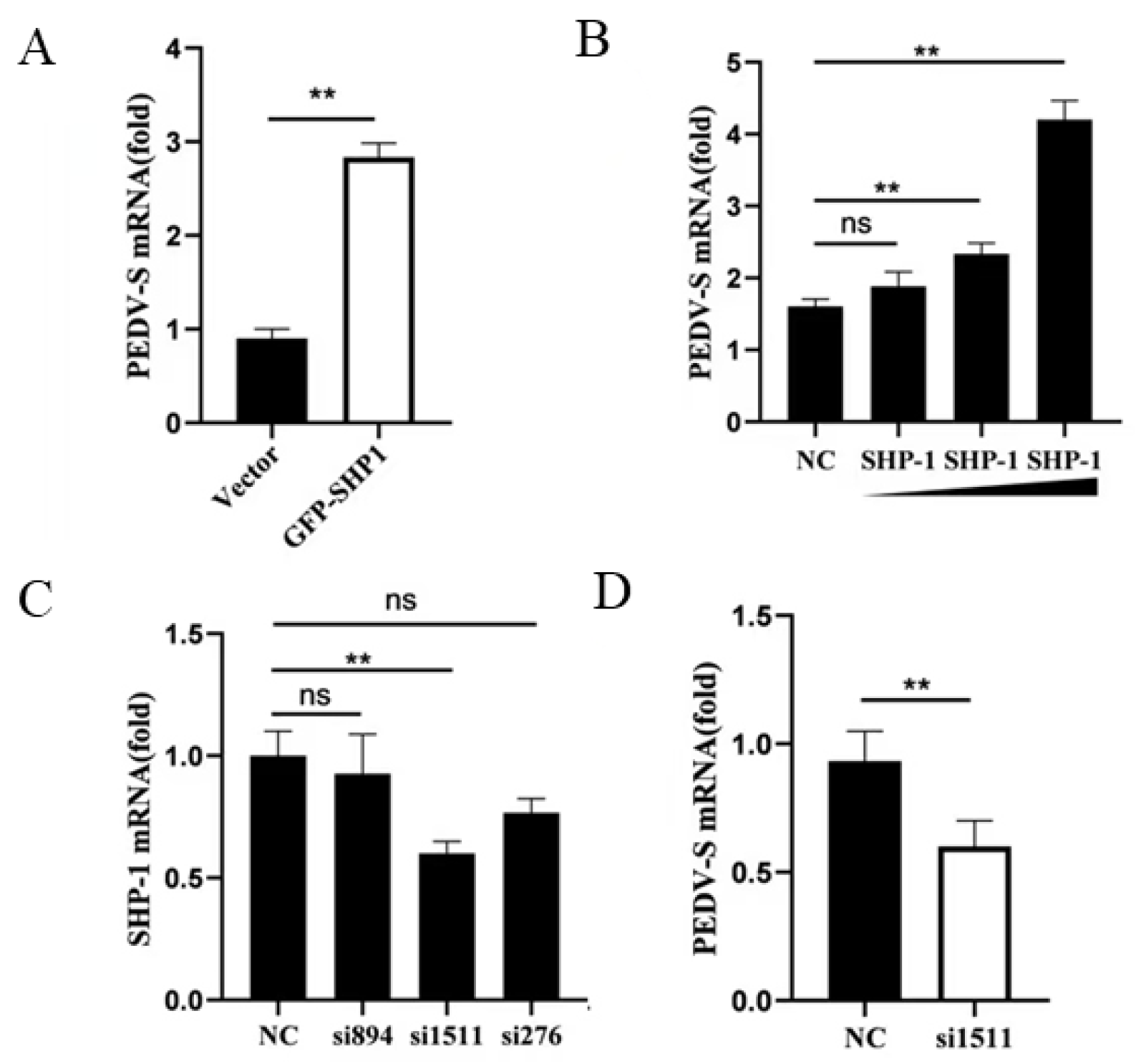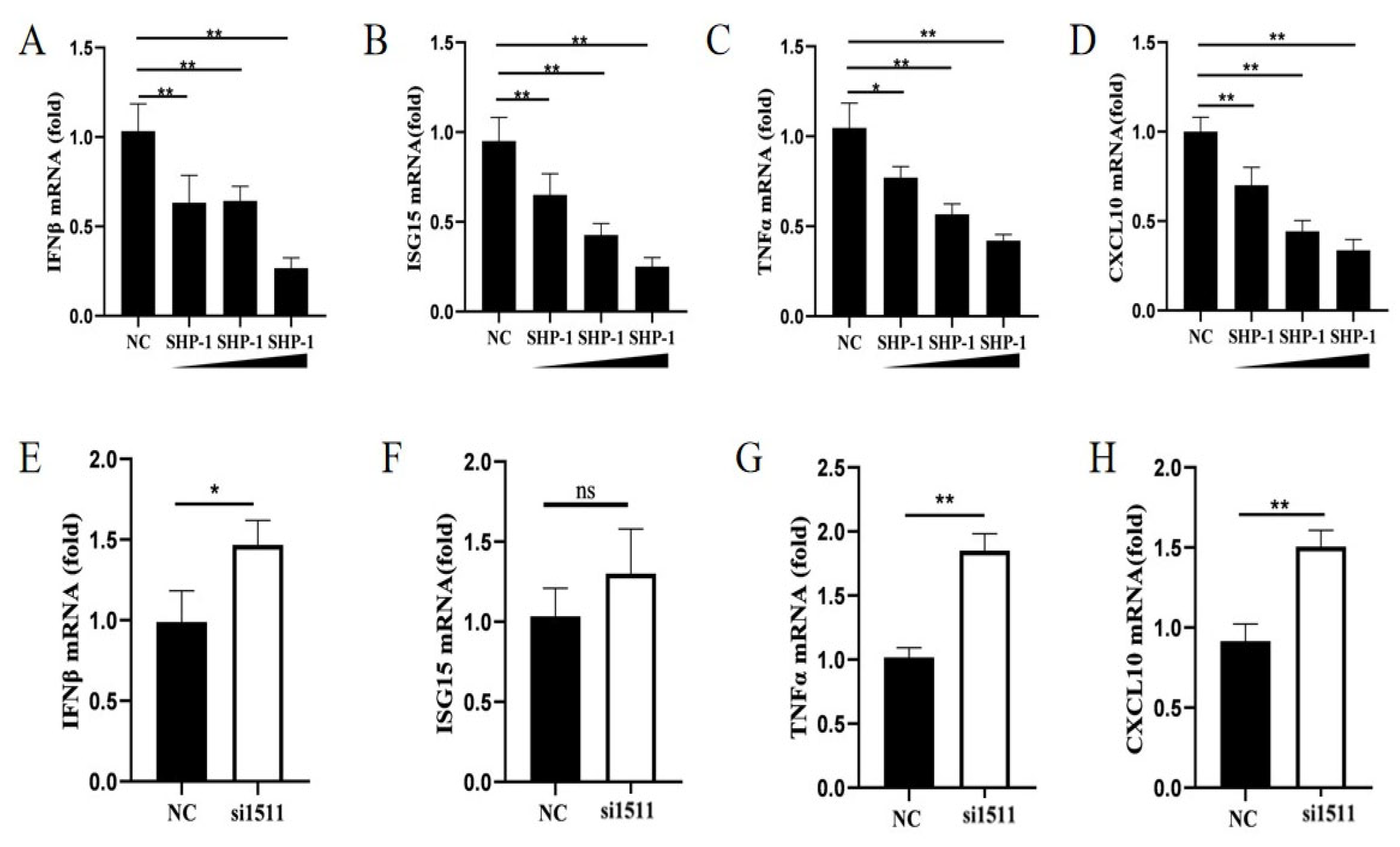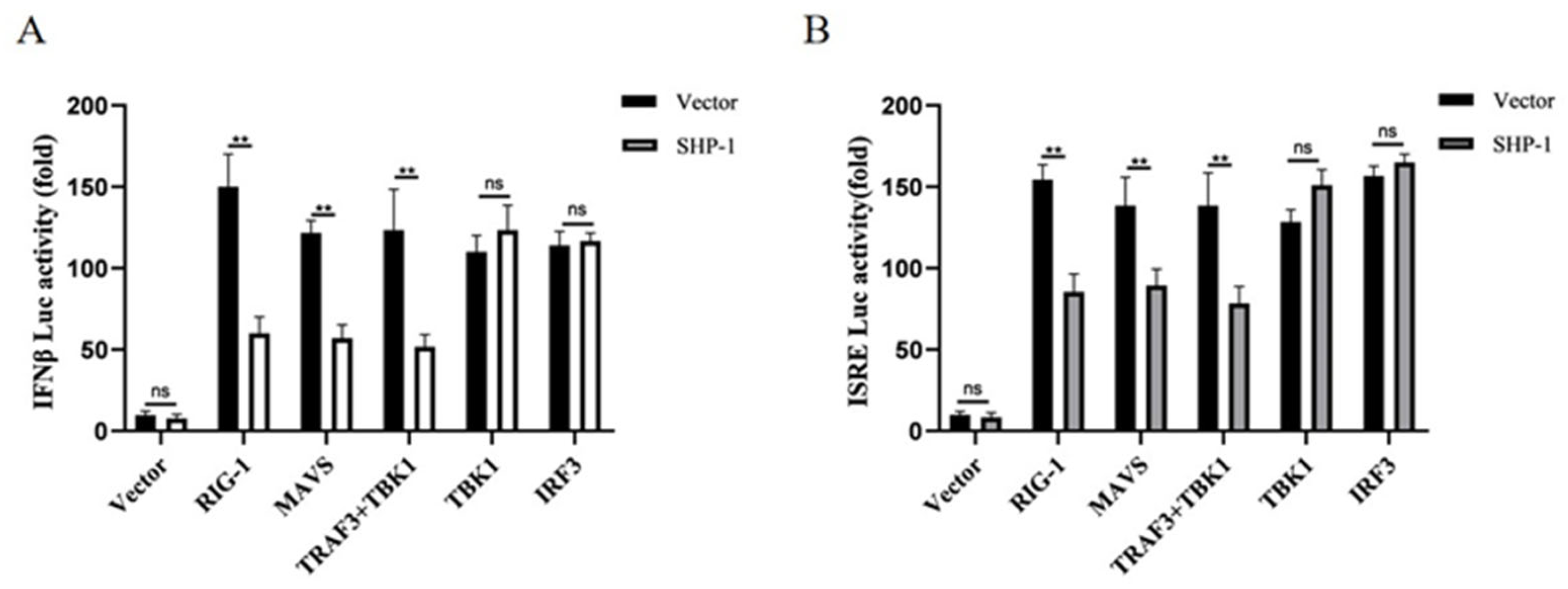SHP-1 Promotes the Replication of Porcine Epidemic Diarrhea Virus by Inhibiting TRAF3-Mediated Type I Interferon Immune Responses
Abstract
1. Introduction
2. Materials and Methods
2.1. Cells and Viruses
2.2. Porcine SHP-1 Gene Clone and Plasmid Constructions
2.3. Quantitative Real-Time PCR (qPCR)
2.4. The Effect of Porcine SHP-1 on PEDV Replication
2.5. The Effects of Porcine SHP-1 on the Expression of IFN-β and Cytokines
2.6. Dual Luciferase Reporter Assay
2.7. Immunofluorescence Assay
2.8. Immunoprecipitation and Western Blot Analysis
2.9. Statistical Analysis
3. Results
3.1. Overexpression of Porcine SHP-1 Promotes Replication of PEDV
3.2. Porcine SHP-1 Downregulates Transcription of IFN-β and Several Cytokines
3.3. Porcine SHP-1 Protein Targets TRAF3 to Negatively Regulate Type I IFN
3.4. Porcine SHP-1 Interacted with TRAF3 and Inhibited K63 Ubiquitination
4. Discussion
5. Conclusions
Author Contributions
Funding
Informed Consent Statement
Data Availability Statement
Acknowledgments
Conflicts of Interest
References
- Zhang, H.; Zou, C.; Peng, O.; Ashraf, U.; Xu, Q.; Gong, L.; Fan, B.; Zhang, Y.; Xu, Z.; Xue, C.; et al. Global Dynamics of Porcine Enteric Coronavirus PEDV Epidemiology, Evolution, and Transmission. Mol. Biol. Evol. 2023, 40, msad052. [Google Scholar] [CrossRef]
- Wood, E. An apparently new syndrome of porcine epidemic diarrhoea. Vet. Rec. 1977, 100, 243–244. [Google Scholar] [CrossRef]
- Pensaert, M.; de Bouck, P. A new coronavirus-like particle associated with diarrhea in swine. Arch. Virol. 1978, 58, 243–247. [Google Scholar] [CrossRef] [PubMed]
- Li, Z.; Zhu, L.; Ma, J.; Zhou, Q.; Song, Y.; Sun, B.; Chen, R.; Xie, Q.; Bee, Y. Molecular characterization and phylogenetic analysis of porcine epidemic diarrhea virus (PEDV) field strains in south China. Virus Genes 2012, 45, 181–185. [Google Scholar] [CrossRef] [PubMed]
- Zhang, Z.; Dong, Y.Q.; Liu, S.; Wu, F.X.; Shao, W.X.; Li, X.C. Survey and surveillance of porcine epidemic diarrhea in some porvinces in China. China Anim. Health Insp. 2014, 31, 47–51. (In Chinese) [Google Scholar]
- Wang, X.; Niu, B.; Yan, H.; Gao, D.; Yang, X. Genetic properties of endemic Chinese porcine epidemic diarrhea virus strains isolated since 2010. Arch. Virol. 2013, 158, 2487–2494. [Google Scholar] [CrossRef]
- Ajayi, T.; Dara, R.; Misener, M.; Pasma, T.; Moser, L.; Poljak, Z. Herd-level prevalence and incidence of porcine epidemic diarrhoea virus (PEDV) and porcine deltacoronavirus (PDCoV) in swine herds in Ontario, Canada. Transbound. Emerg. Dis. 2018, 65, 1197–1207. [Google Scholar] [CrossRef]
- Hsueh, F.C.; Lin, C.N.; Chiou, H.Y.; Chia, M.Y.; Chiou, M.T.; Haga, T.; Kao, C.F.; Chang, Y.C.; Chang, C.Y.; Jeng, C.R.; et al. Updated phylogenetic analysis of the spike gene and identification of a novel recombinant porcine epidemic diarrhoea virus strain in Taiwan. Transbound. Emerg. Dis. 2020, 67, 417–430. [Google Scholar] [CrossRef]
- Jensen, S.; Thomsen, A.R. Sensing of RNA Viruses: A Review of Innate Immune Receptors Involved in Recognizing RNA Virus Invasion. J. Virol. 2012, 86, 2900–2910. [Google Scholar] [CrossRef]
- Schneider, W.; Chevillotte, M.; Rice, C. Interferon-Stimulated Genes: A Complex Web of Host Defenses. Annu. Rev. Immunol. 2014, 32, 513–545. [Google Scholar] [CrossRef]
- Hubel, P.; Urban, C.; Bergant, V.; Schneider, W.M.; Knauer, B.; Stukalov, A.; Scaturro, P.; Mann, A.; Brunotte, L.; Hoffmann, H.H.; et al. A protein-interaction network of interferon-stimulated genes extends the innate immune system landscape. Nat. Immunol. 2019, 20, 493–502. [Google Scholar] [CrossRef] [PubMed]
- Ivashkiv, L.B.; Donlin, L.T. Regulation of type I interferon responses. Nat. Rev. Immunol. 2014, 14, 36–49. [Google Scholar] [CrossRef] [PubMed]
- Poole, A.W.; Jones, M.L. A SHPing tale: Perspectives on the regulation of SHP-1 and SHP-2 tyrosine phosphatases by the C-terminal tail. Cell Signal. 2005, 17, 1323–1332. [Google Scholar] [CrossRef] [PubMed]
- Craggs, G.; Kellie, S. A functional nuclear localization sequence in the C-terminal domain of SHP-1. J. Biol. Chem. 2001, 276, 23719–23725. [Google Scholar] [CrossRef]
- Hao, D.; Wang, Y.; Li, L.; Qian, G.; Liu, J.; Li, M.; Zhang, Y.; Zhou, R.; Yan, D. SHP-1 suppresses the antiviral innate immune response by targeting TRAF3. FASEB J. 2020, 34, 12392–12405. [Google Scholar] [CrossRef]
- Garg, M.; Wahid, M.; Khan, F.D. Regulation of peripheral and central immunity: Understanding the role of Src homology 2 domaincontaining tyrosine phosphatases, SHP-1 & SHP-2. Immunobiology 2019, 225, 151847. [Google Scholar]
- Sharma, Y.; Bashir, S.; Bhardwaj, P.; Ahmad, A.; Khan, F. Protein tyrosine phosphatase SHP-1: Resurgence as new drug target for human autoimmune disorders. Immunol. Res. 2016, 64, 804–819. [Google Scholar] [CrossRef]
- Li, S.; Wang, L.; Wen, Y.; Han, J.; Hou, J.; Hou, Z.; Xie, J.; Li, H.; Li, X.; Yang, Y.; et al. Porcine epidemic diarrhea virus nsp14 inhibited IFN-I production by targeting RIG-I for degradation. Virology 2025, 605, 110451. [Google Scholar] [CrossRef]
- Zhang, Q.; Shi, K.; Yoo, D. Suppression of type I interferon production by porcine epidemic diarrhea virus and degradation of CREB-binding protein by nsp1. Virology 2016, 489, 252–268. [Google Scholar] [CrossRef]
- Ding, Z.; Fang, L.; Jing, H.; Zeng, S.; Wang, D.; Liu, L.; Zhang, H.; Luo, R.; Chen, H.; Xiao, S. Porcine epidemic diarrhea virus nucleocapsid protein antagonizes beta interferon production by sequestering the interaction between IRF3 and TBK1. J. Virol. 2014, 88, 8936–8945. [Google Scholar] [CrossRef]
- Dong, S.; Kong, N.; Qin, W.; Zhai, H.; Zhai, X.; Yang, X.; Ye, C.; Ye, M.; Liu, C.; Yu, L.; et al. ATG4B hinders porcine epidemic diarrhea virus replication through interacting with TRAF3 and activating type-I IFN signaling. Vet. Microbiol. 2022, 273, 109544. [Google Scholar] [CrossRef] [PubMed]
- Zhou, H.; Yan, Y.; Gao, J.; Ma, M.; Liu, Y.; Shi, X.; Zhang, Q.; Xu, X. Heterogeneous Nuclear Protein U Degraded the m6A Methylated TRAF3 Transcript by YTHDF2 To Promote Porcine Epidemic Diarrhea Virus Replication. J. Virol. 2023, 97, e0175122. [Google Scholar] [CrossRef] [PubMed]
- Yuan, C.; Sun, L.; Chen, L.; Guo, H.; Yao, Z.; Wang, Y.; Zhu, W.; Li, T.; Song, Q.; Li, H. Chemokines induced by PEDV infection and chemotactic effects on monocyte, T and B cells. Vet. Microbiol. 2022, 275, 109599. [Google Scholar] [CrossRef] [PubMed]
- Yu, L.; Dong, J.; Wang, Y.; Zhang, P.; Liu, Y.; Zhang, L.; Liang, P.; Wang, L.; Song, C. Porcine epidemic diarrhea virus nsp4 induces pro-inflammatory cytokine and chemokine expression inhibiting viral replication in vitro. Arch. Virol. 2019, 164, 1147–1157. [Google Scholar] [CrossRef]
- Hsueh, F.C.; Chang, Y.C.; Kao, C.F.; Hsu, C.W.; Chang, H.W. Intramuscular Immunization with Chemokine-Adjuvanted Inactive Porcine Epidemic Diarrhea Virus Induces Substantial Protection in Pigs. Vaccines 2020, 8, 102. [Google Scholar] [CrossRef]
- Tong, J.; Zhou, L.; Li, S.; Lu, L.; Li, Z.; Li, Z.; Gan, R.; Mou, C.; Zhang, Q.; Wang, Z.; et al. Two Duplicated Ptpn6 Homeologs Cooperatively and Negatively Regulate RLR-Mediated IFN Response in Hexaploid Gibel Carp. Front. Immunol. 2021, 12, 780667. [Google Scholar] [CrossRef]
- Kolakofsky, D.; Le Mercier, P.; Nishio, M.; Blackledge, M.; Crépin, T.; Ruigrok, R.W.H. Sendai Virus and a Unified Model of Mononegavirus RNA Synthesis. Viruses 2021, 13, 2466. [Google Scholar] [CrossRef]
- Yang, Q.; Zhang, Q.; Zhang, X.; You, L.; Wang, W.; Liu, W.; Han, Y.; Ma, C.; Xu, W.; Chen, J.; et al. HoxA10 Facilitates SHP-1-Catalyzed Dephosphorylation of p38 MAPK/STAT3 To Repress Hepatitis B Virus Replication by a Feedback Regulatory Mechanism. J. Virol. 2019, 93, e01607-18. [Google Scholar] [CrossRef]
- Lin, M.; Ji, X.; Lv, Y.; Cui, D.; Xie, J. The Roles of TRAF3 in Immune Responses. Dis. Markers 2023, 2023, 7787803. [Google Scholar] [CrossRef]




| Genes | Primer Sequences (5′-3′) |
|---|---|
| RIG-I | F: gacgataaggaattcgagctcATGACAGCAGAGCAGCGGC |
| R: ccgggtaccatcgatgagctcTCACTCAAGGTTGCCCATTCC | |
| MAVS | F: gacgataaggaattcgagctcATGACGTTTGCCGAGGACAA |
| R: ccgggtaccatcgatgagctcTCACTGGGGCAGGCGCCG | |
| TRAF3 | F: gatgacgacgataaggaattcATGACACACAGAATGGAGCCG |
| R; attaagatctgctagctcgagTCAGGGGTCAGGCAGATCC | |
| TBK1 | F: gacgataaggaattcgagctcATGCAGAGCACTTCTAATCATCTTTG |
| R: ccgggtaccatcgatgagctcCTAAAGACAGTCAACATTGCGAAGG | |
| IRF3 | F: gacgataaggaattcgagctcATGGGAACTCAGAAGCCTCGG |
| R: ccgggtaccatcgatgagctcCTAGAAATCCATGTCCTCCACCA | |
| IRF7 | F: gacgataaggaattcgagctcATGGCCGCGGCTCCTGAC |
| R: ccgggtaccatcgatgagctcCTAGGCCGGCTGCTCCAC | |
| SHP-1 | F: gttccagattacgctgaattcATGTTGTCCCGTGGGTGGT |
| R: attaagatctgctagctcgagTCACTTCCTCTTCAGGGAGCC |
| Genes | Primer Sequences (5′-3′) |
|---|---|
| qSHP-1 | F: GCAGATGGTGTGGCAGGAGAAC |
| R: GTGACAGCGTAGGGTCCGTAAAC | |
| qIFN-β | F: TGCATCCTCCAAATCGCTCT |
| R: ATTGAGGAGTCCCAGGCAAC | |
| qTNF-α | F: ACCACGCTCTTCTGCCTACTG |
| R: TGAGACGATGATCTGAGTCCTTGG | |
| qISG15 | F: GGCAGCACAGTCCTGTTGATGG |
| R: TGCGTCAGCCAGACCTCATAGG | |
| qCXCL10 | F: ACTGTTCGCTGTACCTGCATCAAG |
| R: GCCTTCGACTCTGGATTCAGACATC | |
| qPEDV-S | F: ACTGCCTATCCAACAAAGCCATTCC |
| R: TTGTCGCAACACGGGACCAATC |
Disclaimer/Publisher’s Note: The statements, opinions and data contained in all publications are solely those of the individual author(s) and contributor(s) and not of MDPI and/or the editor(s). MDPI and/or the editor(s) disclaim responsibility for any injury to people or property resulting from any ideas, methods, instructions or products referred to in the content. |
© 2025 by the authors. Licensee MDPI, Basel, Switzerland. This article is an open access article distributed under the terms and conditions of the Creative Commons Attribution (CC BY) license (https://creativecommons.org/licenses/by/4.0/).
Share and Cite
Hu, J.; Kong, Y.; Liu, Y.; Li, N.; Jiang, S. SHP-1 Promotes the Replication of Porcine Epidemic Diarrhea Virus by Inhibiting TRAF3-Mediated Type I Interferon Immune Responses. Pathogens 2025, 14, 1014. https://doi.org/10.3390/pathogens14101014
Hu J, Kong Y, Liu Y, Li N, Jiang S. SHP-1 Promotes the Replication of Porcine Epidemic Diarrhea Virus by Inhibiting TRAF3-Mediated Type I Interferon Immune Responses. Pathogens. 2025; 14(10):1014. https://doi.org/10.3390/pathogens14101014
Chicago/Turabian StyleHu, Jiaqing, Yuxin Kong, Yi Liu, Ning Li, and Shijin Jiang. 2025. "SHP-1 Promotes the Replication of Porcine Epidemic Diarrhea Virus by Inhibiting TRAF3-Mediated Type I Interferon Immune Responses" Pathogens 14, no. 10: 1014. https://doi.org/10.3390/pathogens14101014
APA StyleHu, J., Kong, Y., Liu, Y., Li, N., & Jiang, S. (2025). SHP-1 Promotes the Replication of Porcine Epidemic Diarrhea Virus by Inhibiting TRAF3-Mediated Type I Interferon Immune Responses. Pathogens, 14(10), 1014. https://doi.org/10.3390/pathogens14101014





